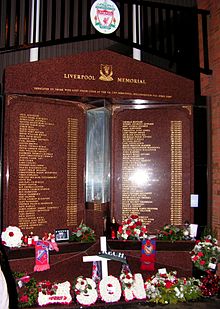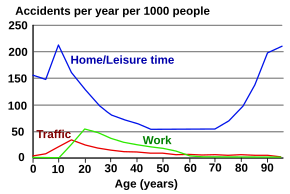Accident

Anaccidentis an unintended, normally unwanted event that was not directly caused by humans.[1]The termaccidentimplies that nobody should beblamed,but the event may have been caused byunrecognized or unaddressed risks.Most researchers who studyunintentional injuryavoid using the termaccidentand focus on factors that increase risk of severe injury and that reduce injury incidence and severity.[2]For example, when a tree falls down during awind storm,its fall may not have been caused by humans, but the tree's type, size, health, location, or improper maintenance may have contributed to the result. Mostcar wrecksare not true accidents; however, English speakers started using that word in the mid-20th century as a result ofmedia manipulationby the US automobile industry.[3]
Types[edit]

Physical and non-physical[edit]
Physical examples of accidents include unintended motor vehicle collisions, tongue biting while eating, electric shock by accidentally touching bare electric wire, drowning,falls,being injured by touching something sharp or hot, or bumping into something while walking.
Non-physical examples are unintentionally revealing asecretor otherwise saying something incorrectly, accidental deletion of data, or forgetting an appointment.
Accidents by activity[edit]
- Accidents during the execution of work or arising out of it are calledwork accidents.According to theInternational Labour Organization(ILO), more than 337 million accidents happen on the job each year, resulting, together with occupational diseases, in more than 2.3 million deaths annually.[4]
- In contrast,leisure-related accidents are mainlysports injuries.
Accidents by vehicle[edit]

This sectionneeds expansionwith: data on vehicular collisions. You can help byadding to it.(December 2023) |
It has been argued by some critics that vehicle collisions are not truly accidents, given that they are mostly caused by preventable causes such asdrunk drivingand intentionally driving too fast, and as such should not be referred to asaccidents.[3]Since 1994, the USNational Highway Traffic Safety Administrationhas asked media and the public to not use the wordaccidentto describe vehicle collisions.[3]
Aviation accidents and incidents[edit]
This sectionneeds expansion.You can help byadding to it.(December 2023) |
Bicycle accidents[edit]
This sectionneeds expansion.You can help byadding to it.(December 2023) |
Maritime incidents[edit]
This sectionneeds expansion.You can help byadding to it.(December 2023) |
Traffic collisions[edit]
This sectionneeds expansion.You can help byadding to it.(December 2023) |
Train wrecks[edit]
This sectionneeds expansion.You can help byadding to it.(December 2023) |
Domino effect accidents[edit]
In the process industry, a primary accident may propagate to nearby units, resulting in a chain of accidents, which is calleddomino effect accident.
Common causes[edit]

Poisons, vehicle collisions and falls are the most common causes of fatal injuries. According to a 2005 survey of injuries sustained at home, which used data from the National Vital Statistics System of the United StatesNational Center for Health Statistics,falls, poisoning, and fire/burn injuries are the most common causes of death.[5]
The United States also collects statistically valid injury data (sampled from 100 hospitals) through the National Electronic Injury Surveillance System administered by theConsumer Product Safety Commission.[6]This program was revised in 2000 to include all injuries rather than just injuries involving products.[6]Data onemergency departmentvisits is also collected through theNational Health Interview Survey.[7]In The U.S. theBureau of Labor Statisticshas available on their website extensive statistics on workplace accidents.[8]
Accident models[edit]

Many models to characterize and analyze accidents have been proposed,[10]which can be classified by type. No single model is the sole correct approach.[11]Notable types and models include:[12]
- Sequential models
- Complex linear models
- Energy damage model[14][full citation needed]
- Time sequence models
- Generalized time sequence model[15][full citation needed]
- Accident evolution and barrier function[16]
- Epidemiological models
- Gordon 1949[citation needed]
- Onward mappings model based on resident pathogens metaphor[17]
- Process model
- Benner 1975[citation needed]
- Systemic models
- Rasmussen
- Reason model of system safety (embedding theSwiss cheese model)
- Woods 1994[citation needed]
- Non-linear models
- System accident[18]
- Systems-theoretic accident model and process (STAMP)[19]
- Functional resonance analysis Method (FRAM)[20]
- Assertions that all existing models are insufficient[21][full citation needed]
Ishikawa diagramsare sometimes used to illustrateroot-cause analysisandfive whysdiscussions.
See also[edit]
General[edit]
- Occupational safety and health
- Safety
- Personal protective equipment
- Safety engineering
- Fail-safe
- Idiot-proof
- Poka-yoke
- Risk management
- Accident analysis
- Accident-proneness
- Injury
- List of accidents and disasters by death toll
Transportation[edit]
- Bicycle safety
- Road vehicle safety
- List of rail accidents
- Tram accident
- Maritime incident
- Air safety
Other specific topics[edit]
- Aisles: Safety and regulatory considerations
- Explosives safety
- Nuclear and radiation accidents
- Sports injury
References[edit]
- ^Woodward, Gary C. (2013).The Rhetoric of Intention in Human Affairs.Lexington Books. p. 41.ISBN978-0-7391-7905-5.
Since 'accidents' by definition deprive us of first-order human causes…
- ^Robertson, Leon S. (2015).Injury Epidemiology: Fourth Edition.Lulu Books.Archivedfrom the original on 2018-01-26.Retrieved2017-12-09.
- ^abcStromberg, Joseph (2015-07-20)."We don't say" plane accident. "We shouldn't say" car accident "either".Vox.Archivedfrom the original on 2021-09-07.Retrieved2021-09-07.
- ^"ILO Safety and Health at WorkArchived2022-01-19 at theWayback Machine".International Labour Organization (ILO)
- ^Runyan CW, Casteel C, Perkis D, et al. (January 2005). "Unintentional injuries in the home in the United States Part I: mortality".Am J Prev Med.28(1): 73–9.doi:10.1016/j.amepre.2004.09.010.PMID15626560.
- ^abCPSC.National Electronic Injury Surveillance System (NEISS)Archived2013-03-13 at theWayback Machine.Database query available through:NEISS Injury DataArchived2013-04-23 at theWayback Machine.
- ^NCHS.Emergency Department VisitsArchived2017-07-11 at theWayback Machine.CDC.
- ^"Injuries, Illnesses, and Fatalities".www.bls.gov.Archivedfrom the original on 2019-06-02.Retrieved2014-04-02.
- ^abH.W. Heinreich (1931).Industrial Accident Prevention.McGraw-Hill.
- ^A long list of books and papers is given in:Taylor, G.A.; Easter, K.M.; Hegney, R.P. (2004).Enhancing Occupational Safety and Health.Elsevier. pp.241–245, see also pp. 140–141, 147–153, also on Kindle.ISBN0750661976.
- ^Kjellen, Urban; Albrechtsen, Eirik (2017).Prevention of Accidents and Unwanted Occurrences: Theory, Methods, and Tools in Safety Management, Second Edition.CRC Press. p. 75.ISBN978-1-4987-3666-4.
- ^Yvonne Toft; Geoff Dell; Karen K Klockner; Allison Hutton (2012). "Models of Causation: Safety". In HaSPA (Health and Safety Professionals Alliance) (ed.).OHS Body of Knowledge(PDF).Safety Institute of Australia Ltd.ISBN978-0-9808743-1-0.Archived(PDF)from the original on 2017-02-25.Retrieved2017-03-25.
- ^Bird, Frank E.; Germain, George L. (1985).Practical Loss Control Leadership.International Loss Control Institute.ISBN978-0880610544.OCLC858460141.
- ^Gibson, Haddon, Viner
- ^Viner
- ^Svenson, Ola (September 1991). "The Accident Evolution and Barrier Function (AEB) Model Applied to Incident Analysis in the Processing Industries".Risk Analysis.11(3): 499–507.Bibcode:1991RiskA..11..499S.doi:10.1111/j.1539-6924.1991.tb00635.x.PMID1947355.
- ^Reason, James T. (1991). "Too Little and Too Late: A Commentary on Accident and Incident Reporting". In Van Der Schaaf, T.W.; Lucas, D.A.; Hale, A.R. (eds.).Near Miss Reporting as a Safety Tool.Butterworth-Heinemann. pp. 9–26.
- ^Perrow, Charles (1984).Normal Accidents: Living with High-Risk Technologies.Basic Books.ISBN978-0465051434.
- ^Leveson, Nancy (April 2004). "A new accident model for engineering safer systems".Safety Science.42(4): 237–270.CiteSeerX10.1.1.141.697.doi:10.1016/S0925-7535(03)00047-X.
- ^Hollnagel, 2012
- ^Dekker 2011
External links[edit]
